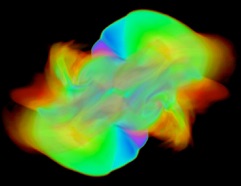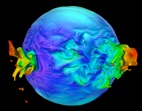A star interacting with a massive black hole cannot be treated as a point mass if its gets too close to the black hole that it becomes vulnerable to tidal distortions and even disruption. When a rapidly changing tidal force starts to compete with a star’s self-gravity, the material of the star responds on a complicated way. It is often assumed that these encounters excite dynamical tidal disturbances, leading to energy dissipation and orbital circularization. However, in the non-linear regime of tides, close encounters between a massive black hole and a star on a nearly parabolic orbit can also lead to mass loss, eccentricity increases, and the ejection of the star.


I am interested in the dynamics of plasma in extreme astrophysical environments. My current goal is to combine high quality numerical simulations with analytical techniques in order to address basic questions in high energy astrophysics. Since my arrival at Santa Cruz, I have been involved in various theoretical aspects of gamma-ray bursts, supernovae, compact binary evolution and dynamics, cosmology, and star formation in dense environments. Some of my current research interests include:


tidal disruption of stars by massive black holes
GRB sources involve energies that can exceed the mass equivalent of 1/100 of a sun. Compared with the size of the sun, the seat of this activity is extraordinarily compact, as indicated by rapid variability of the radiation flux on millisecond timescales. It is unlikely that mass can be converted into energy with better than a few per cent efficiency; therefore, the more powerful GRB sources must process upwards a 1/10 of a solar mass through a region which is not much larger than the size of a neutron star or a stellar mass black hole.
triggering gamma-ray bursts







ultra-compact binaries as probes of extreme physics

Interacting binaries allow us to probe stellar evolution processes that cannot be studied in single stars. They also give rise to energetic, accretion-driven phenomena as such as type Ia supernovae and gamma-ray bursts, that can be used to identify and study stellar populations out to cosmological distances. They are also spectacular probes of the extreme physics at high energy and high density, being strong gravitational wave sources
Galactic nuclei and globular clusters act as laboratories in which nature experiments with normal stars, neutron stars and black holes, through collisions and through the formation of bound states, in the form of binaries. Dynamical interactions between passing stars can form new binaries and modify the properties and even the membership of existing binaries.






